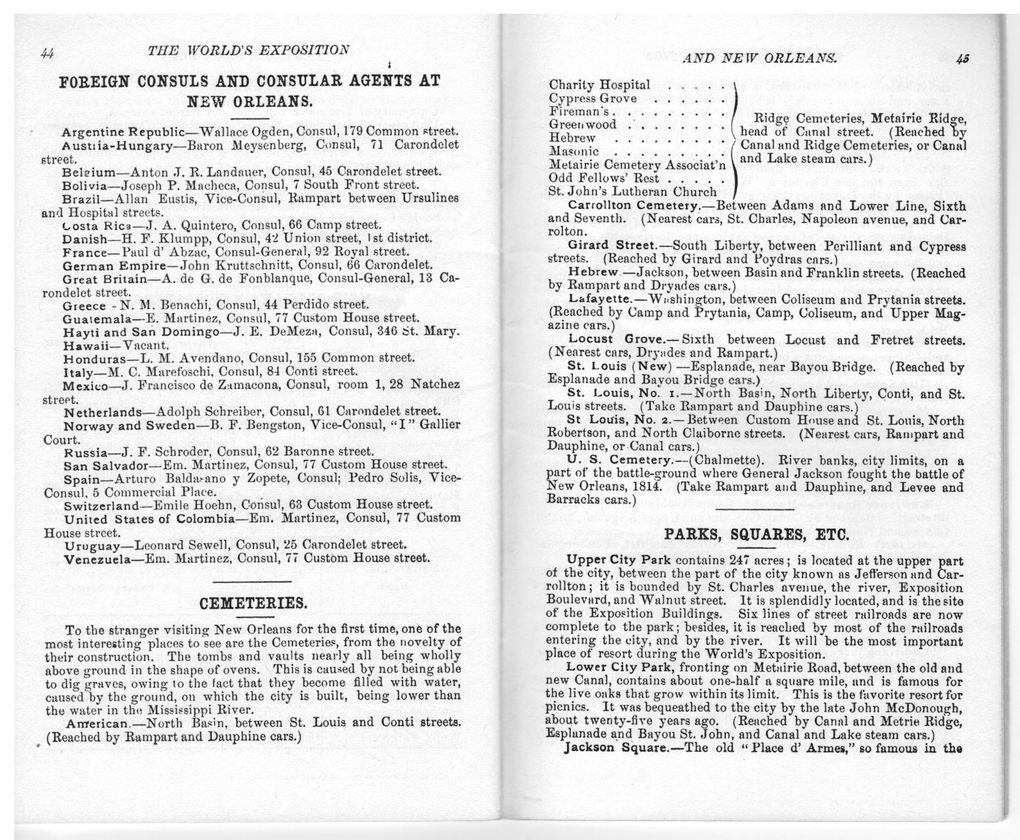This text was obtained via automated optical character recognition.
It has not been edited and may therefore contain several errors.
u THE WORLD'S EXPOSITION i FOREIGN CONSULS AND CONSULAR AGENTS AT NEW ORLEANS. Argentine Republic—Wallace Ogden, Consul, 179 Common street. Austiia-Hungary—Baron Aleysenberg, Consul, 71 Carondelet street. Belsium—Anton .T. R. Landauer, Consul, 45 Carondelet street. Bolivia—Joseph P. Machcca, Consul, 7 South Front street. Brazil—Allan Eustis, Vice-Consul, Rampart between Ursulines and Hospital streets. Costa Rica—J. A. Quintero, Consul, 66 Camp street. Danish—H. F. Klumpp, Consul, 42 Union street, 1st district. France—Paul d’ Abzac, Consul-General, 92 Royal street. German Empire—John Kruttschnitt, Consul, 66 Carondelet. Great Britain—A. de G. de Fonblanque, Consul-General, 13 Ca-rondelot street. Gieece -N. M. Benachi, Consul, 44 Perdido street. Guaiemala—E. Martinez, Consul, 77 Custom House street. Hayti and San Domingo—J. E. DeMeza, Consul, 346 St. Mary. Hawaii—Vacant. Honduras—L. M. Avendano, Consul, 155 Common street. Italy—M. C. Marefoschi, Consul, 84 Conti street. Mexico—J. Francisco de Zsmacona, Consul, room 1, 28 Natchez street. Netherlands—Adolph Schreiber, Consul, 61 Carondelet street. Norway and Sweden—B. F. Bengston, Vice-Consul, “I” Gallier Court. Russia—J. F. Schroder, Consul, 62 Baronne street. San Salvador—Em. Martinez, Consul, 77 Custom House street. Spain—Arturo Balda>ano y Zopete, Consul; Pedro Solis, Vice-Consul, 5 Commercial Place. Switzerland—Emile Hoehn, Consul, 63 Custom House street. United States of Colombia—Em. Martinez, Consul, 77 Custom House street. Uruguay—Leonard Sewell, Consul, 25 Carondelet street. Venezuela—Em. Martinez, Consul, 77 Custom House street. CEMETERIES. To the stranger visiting New Orleans for the first time, one of tbe most interesting places to see are the Cemeteries, from the novelty of their construction. The tombs and vaults nearly all being wholly above ground in the shape of ovens. This is caused by not being able to dig graves, owing to the lact that they become filled with water, caused by the ground, on which the city is built, being lower than the water in the Mississippi River. American.—North Basin, between St. Louis and Conti streets. (Reached by Rampart and Dauphine cars.) AND NEW ORLEANS. Charity Hospital ..........I Cypress Grove .............j Gree'hwood ................[, Ri<%? Cemeteries, Metairie Rid™, Hebrew ....................^ head of Canal street. (Reached by 2jasonic.................../ Canal and Ridge Cemeteries, or Canal Metairie Cemetery Associat’n I an<^ steam car».) Odd Fellows’ Rest..........I St.John’s Lutheran Church / Carrollton Cemetery.—Between Adams and Lower Line, Sixth and Seventh. (Nearest cars, St. Charles, Napoleon avenue, and Car-rolton. Girard Street.—South Liberty, between Perilliant and Cypress streets. (Reached by Girard and Poydras cars.) Hebrew—Jackson, between Basin and Franklin streets. (Reached by Rampart and Dryades cars.) Lafayette.—Washington, between Coliseum and Prytania streets. (Reached by Camp and Prytania, Camp, Coliseum, and Upper Magazine cars.) Locust Grove.— Sixth between Locust and Fretret streets. (Nearest cars, Dryades and Rampart.) St. Louis (New) —Esplanade, near Bayou Bridge. (Reached by Esplanade and Bayou Bridge cars.) St. Louis, No. i.—North Basin, North Liberty, Conti, and St. Louis streets. (Take Rampart and Dauphine cars.) St Louis, No. 2. —Between Custom House and St. Louis, North Robertson, and North Claiborne streets. (Nearest cars, Rampart and Dauphine, or Canal cars.) U. S. Cemetery.—(Chalmette). River banks, city limits, on a part of the battle-ground where General Jackson fought the battle of New Orleans, 1814. (Take Rampart and Dauphine, and Levee and Barracks cars.) PARKS, SQUARES, ETC. Upper City Park contains 247 acres; is located at the upper part of the city, between the part of the city known as Jefferson and Carrollton; it is bounded by St. Charles avenue, the river, Exposition Boulevard, and Walnut street. It is splendidly located, and is the site of the Exposition Buildings. Six lines of street railroads are now complete to the park; besides, it is reached by most of the railroads entering the city, and by the river. It will be the most important place of resort during the World’s Exposition. Lower City Park, fronting on Metairie Road, between the old and new Canal, contains about one-half a square mile, and is famous for the live oaks that grow within its limit. This is the favorite resort for picnics. It was bequeathed to the city by the late John McDonough, about twenty-five years ago. (Reached by Canal and Metrie Ridge, Esplanade and Bayou St. .John, and Canal and Lake steam cars.) Jackson Square.—The old “Place d’Armes,” so famous in tha

New Orleans Centennial World Exposition 1884 Visitor Guide (27)